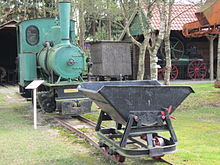Elisabethfehn Moor and Fen Museum
The moor and fen museum Elisabethfehn is a moor museum in the fen colony Elisabethfehn , municipality of Barßel . The museum is located directly on the Elisabethfehn Canal in the area of the now almost completely cultivated Easter bog .
history
The Moor and Fehn Museum was founded on June 6, 1986 by the local and beautification association Elisabethfehn on the initiative of its chairman Gustav Schünemann. Historical and old machines for cutting peat are shown on an area of 15,000 m² . The history of the moor and peat extraction are clearly presented.
The museum was built in an old canal keeper's house built in 1896 and in a typical Fehnhaus from 1993. It offers a very interesting collection and detailed information on bog, peat and bog colonization .
Inside the museum building visitors will include the topics "Origin of Moore ," "mire types", " Flora and Fauna of Moore", " Moor Archeology ", "social history of the bog settlements" and the " cultivation (Fehnkultur, German high moorland culture , sand mixed culture) and use of the moors ”is explained in detail using pictures, exhibits, models and descriptions.
Since 2011, this is a permanent exhibit child from the Esterweger box , one in the marsh west of the Saterland in Burlage (Rhauderfehn) excavated skeleton bog body issued a 12-14-year-old boy from the period around the year 1100 n. Chr., Also known as boy Burlage is known. In addition, the museum has a lock of hair, the only remaining remnant of the bog body of the man from Kreepen , which was destroyed in 1945 during air raids with the Berlin Ethnographic Museum.
In the open space belonging to the museum, a moor teaching garden has been set up with over 90 typical plant species from the raised and fens. In addition, u. a. available: a living high and fen , Moor level , which represent the origin of the moor, a Moorkate, a buckwheat field , reproduction of boardwalks , a complete Weißtorffabrik, a large number of Torfgroßgeräten (bulldozers, excavators, piercing machines, sod collector), the narrow-gauge locomotive " Katharina ”and a very well preserved locomobile (built in 1904).
The museum has three ships: The iron tjalk "Jantina" was built in 1900 in Dokkum in West Friesland , is 14.9 meters long, approximately 3.4 meters wide, weighs 15 tons and can load 28.7 tons. Then the museum also has a wooden mother ship “Johanna”. This is an original replica of a mother from around 1900 and was recreated by the museum itself and is 15.70 meters long and 3.60 meters wide. There is also a pogge there .
There are annually changing special exhibitions. These special exhibitions inform the visitor about interesting facts from the fields of moor and peat science, about regional characteristics, scientific topics and interesting collector areas. Once a month (on Sundays) there is a show baking in an old Saterland stone oven .
The museum is a station on the Route of Industrial Culture in the northwest and thus part of the European Route of Industrial Culture . Father Laurentius M. Siemer OP (1888–1956), from whom the grammar school in neighboring Ramsloh takes its name, was born in the canal keeper's house of the museum . Museum director was Gustav Schünemann from the time it was founded until October 31, 2011. His successor has been Antje Hoffmann since November 1, 2011. The museum has been part of a foundation since 2009 . On April 8, 2011, the museum celebrated its 25th anniversary.
literature
- Gustav Schünemann: The moor and fen museum Elisabethfehn . In: Yearbook for the Oldenburger Münsterland 1990 : Vechta 1989. pp. 353–359
- Katrin Zempel-Bley: Bringing the spirit of invention to life. Moor- und Fehnmuseum conceives special exhibition about peat pioneers . In: Kulturland Oldenburg (Ed .: Oldenburgische Landschaft). Edition 4.2016 (No. 170), pp. 18ff.
Web links
- Museum website
- Certificate for a Lifetime Achievement (NWZ)
- Video on You Tube
- Museumstjalk Jantina: Plastic surgery for the iron lady
- Certification: National recognition for the museum
- Elisabethfehn Moor and Fehn Museum is about to be recognized by the state
- Moor- und Fehnmuseum receives the last peat briquette press ( Memento from February 11, 2013 in the web archive archive.today )
- The moor and fen museum steps on the gas
- Special exhibition in the Moor and Fehn Museum ( Memento from February 6, 2013 in the web archive archive.today )
- Museum visitors practiced towing ( memento from February 11, 2013 in the web archive archive.today )
- Pioneers in the peat industry
- Foundation runs moor and fen museum
- Scary stories from ancient moorland
Coordinates: 53 ° 9 ′ 0 ″ N , 7 ° 42 ′ 36 ″ E

